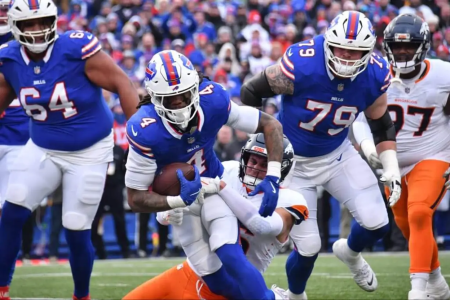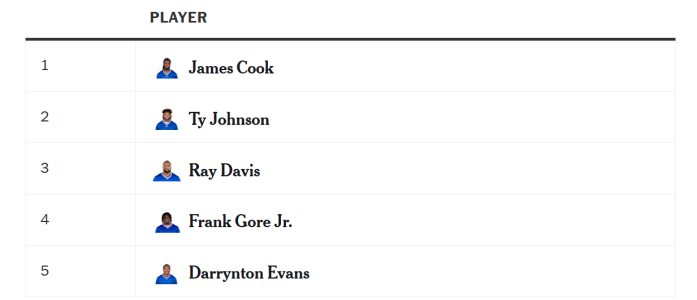
Bills training camp 2025 running backs preview: Why change what worked?
The running backs room is probably going to look a lot like last year's.

In 2024, the Bills achieved some of their best success running the ball, as they have done since head coach Sean McDermott arrived in 2017. With some shifting philosophies throughout the NFL, rushing attacks are making a bit of a comeback, and the Bills definitely found some answers to help their offensive environment last season.
What will the team do for an encore in 2025? And given some of the conversations surrounding the running back room this spring, how will that impact what they want to do this coming season?
With plenty of pieces to consider, here is a detailed running back outlook for when the Bills return for training camp in late July.
2025 Bills projected RB depth chart
What’s changed?
The Bills changed absolutely nothing about their running back room in the offseason, not even adding a new undrafted free agent to the position. The same five running backs in training camp last year are the ones signed to the team this year. James Cook and Ray Davis remained under contract, Frank Gore Jr. signed a reserve/futures deal at the end of the year and Ty Johnson re-signed on a new two-year deal. They even brought Darrynton Evans back, after they put him on Injured Reserve in late August and released him from IR in late October. He spent the rest of his year with the Bears, only to sign with the Bills in the offseason.
Biggest question
Will the Bills increase Cook’s role in 2025?
The contract conversation surrounding Cook is one thing, but the on-field component is the most important piece. However, the way the Bills decide to use Cook in 2025 could have an impact on the contract side of things because, as it stands now, Cook’s overall role is one of the biggest reasons for hesitation in making him one of the highest-paid at his position in the NFL. There is no doubt about Cook’s impact when he was given the ball last season. His rushing efficiency was excellent, and he delivered on all the potential that the Bills saw in him through his first two seasons. But even with a spike in production and touchdown rate, Cook’s role shifted from 2023 to 2024.
In 2023, Cook was on the field for 54.6 percent of the team’s offensive snaps. Given his abilities shown that season, the general idea is that his on-field role was more likely to increase than anything heading into his third season. Except, the opposite happened. Cook’s on-field role during his games played actually decreased to 47.5 percent in 2024 as the Bills’ backfield effectively became a committee without being nationally branded as such due to Cook’s rushing metrics and gaudy touchdown numbers. Johnson came in with a 30.9 percent offensive snap rate, with Davis registering at 22 percent. With Joe Brady in charge at the end of 2023, Cook took over half of the offensive snaps every game from Week 15 through the Bills’ playoff exit — and that was in a backfield with Johnson, mind you. Of course, the role isn’t everything, but it is worth noting that in 2022, Devin Singletary actually took 64.6 percent of all the team’s offensive snaps, and Cook was on that roster.
It’s worth wondering how the Bills view Cook moving forward. If they think he’s at his best in a 50 percent or less role to maximize the time he’s on the field, that certainly makes it difficult to justify paying him a massive new contract. Of the top 12 highest-paid running backs, 11 of them took at least 57 percent of their teams’ offensive snaps in games they were active in 2024. Derrick Henry fell just below the 60 percent mark, and the other 10 all were at 60 percent or higher. Of the highest paid, four of the top five were at 70 percent or higher. It’s also worth noting that the Bills have yet to issue a lucrative long-term deal to a running back since general manager Brandon Beane arrived. It’s not as though he’s against it, but he’s looking for an anomaly at the position to justify taking up that high of a cap percentage, and has often referenced Christian McCaffrey and Alvin Kamara as the do-it-all backs of the league. Mind you, McCaffrey and Kamara are both two of the highest-paid, and are in the 70 percent and up snap percentage club. So, it all factors into the inevitable conversation revolving around Cook as camp approaches.
How do the Bills view him heading into 2025? Is he someone they are depending on to become one of the higher-snap running backs in the league and take a big step forward as a player? Or, do they think they found the perfect role for him as the top snap earner in a committee? Given their success running the ball and with their backfield on the whole, it wouldn’t be a surprise if they went with the latter, perhaps with a slight uptick in playing time for Cook. But even that’s difficult to project because Davis showed well last season, and there could be plans to get him a bit more involved in 2025. So it’s a two-pronged conversation. The playing time impacts the contract conversation, and the contract conversation is what makes it all such an interesting discourse on the topic as to whether the Bills will pay a running back well for the first time since Beane arrived.
Potential camp battle
Ty Johnson vs. Ray Davis
While we wonder about Cook’s role as he enters his fourth season, it’s also worth monitoring whether Davis can convince the Bills to increase his role in 2025 all the same. Last season, Davis was a distant third in terms of role. Although he was active for every game in 2024, Davis was on the field for only 22 percent of the Bills’ offensive snaps. When you remove two games — the Week 6 game against the Jets when Cook was injured and didn’t play, and the starter-resting Week 18 matchup with the Patriots — the season snap rate of Davis decreases to 18 percent. But when the Bills gave Davis those two games of increased usage, he put together two of his best performances of the season. His outing against the Jets as the top back was a bit eye-opening, as he was an all-around threat both between the tackles and then as a pass catcher. If anyone tried to pigeonhole Davis as a between-the-tackles-only runner, his good hands and receiving skills were displayed that evening to dispel those thoughts. Although it’s a smaller sample size, that three-down ability will likely not be an afterthought.
The problem for Davis is that he has both Cook and Johnson standing in his way, just as last season. Johnson’s work on third downs was the catalyst for them bringing him back on a two-year deal, the first of which is fully guaranteed. Johnson wasn’t just someone who took snaps, he was a strength to them on those snaps. His speed and pass-catching skills helped fill the role that maybe they thought Cook would have been best suited for when they initially drafted Cook. Cook became such a good early-down back that he opened a lane for Johnson to shine, which was conducive to Johnson’s skill set, and he took full advantage.
The question is whether Johnson can hold off Davis for that same role in 2025, especially given Davis’ potential, that he still has three years remaining on his rookie deal and is two years younger than Johnson. Johnson’s contract can be reduced to basically a one-year commitment, to which they could move on next offseason and save over $2 million in cap space. That could be enough to at least see if Davis can handle a bigger workload more consistently. The secondary piece of it is if the Bills will want to change up any bit of their approach with the running back room this year. The Bills’ rushing offense in 2024 was their best in several seasons, so there’s a chance they don’t want to tinker with it and keep it uniform to last season, barring injuries. However, if Davis shows a notable step forward in his second summer with the team, it could force the Bills’ hand to have him play more snaps in his second season, which would likely directly impact Johnson.
Special teams
The Johnson and Davis duo can fit into the special teams mix this season, just as they did in 2024. Johnson likely won’t be a four-unit special teams asset, but he can certainly fit in on punt coverage and kickoff return if they need him to. Davis could also fill in on punt coverage duties, but his top special teams role could be as one of their kickoff returners. How Davis catches the ball from a kickoff away from his body and in stride is impressive, giving him a potential leg up on kickoff coverage unit trying to tackle him. Given the nature of his position on offense, his vision to read blockers and defenders in the open field, along with the ability to fight through contact, could make him a really compelling option to return kicks this year, which could then save a roster spot by allowing the Bills to move on from return specialist Brandon Codrington.
Who makes it and why?
James Cook, Ty Johnson and Ray Davis
The Bills enter camp with the same five running backs as last year, and I believe they’ll head into the regular season with the same three running backs as last year, too. Cook, Johnson and Davis will be the trio, and all three have their roles within the Bills offense. It would be a relatively big surprise if, for non-injury reasons, the running back room was anything but these three. What the room will look like in 2026 is another question entirely, but for now, this group seems like one of the safest bets of the summer.
